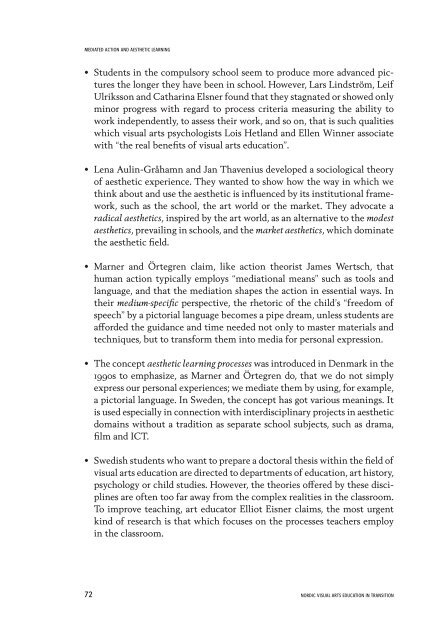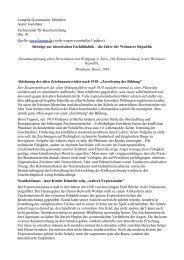Research in Visual Arts Education - The National Society for ...
Research in Visual Arts Education - The National Society for ...
Research in Visual Arts Education - The National Society for ...
You also want an ePaper? Increase the reach of your titles
YUMPU automatically turns print PDFs into web optimized ePapers that Google loves.
MEDIATED ACTION AND AESTHETIC LEARNING<br />
• Students <strong>in</strong> the compulsory school seem to produce more advanced pictures<br />
the longer they have been <strong>in</strong> school. However, Lars L<strong>in</strong>dström, Leif<br />
Ulriksson and Cathar<strong>in</strong>a Elsner found that they stagnated or showed only<br />
m<strong>in</strong>or progress with regard to process criteria measur<strong>in</strong>g the ability to<br />
work <strong>in</strong>dependently, to assess their work, and so on, that is such qualities<br />
which visual arts psychologists Lois Hetland and Ellen W<strong>in</strong>ner associate<br />
with “the real benefits of visual arts education”.<br />
• Lena Aul<strong>in</strong>-Gråhamn and Jan Thavenius developed a sociological theory<br />
of aesthetic experience. <strong>The</strong>y wanted to show how the way <strong>in</strong> which we<br />
th<strong>in</strong>k about and use the aesthetic is <strong>in</strong>fluenced by its <strong>in</strong>stitutional framework,<br />
such as the school, the art world or the market. <strong>The</strong>y advocate a<br />
radical aesthetics, <strong>in</strong>spired by the art world, as an alternative to the modest<br />
aesthetics, prevail<strong>in</strong>g <strong>in</strong> schools, and the market aesthetics, which dom<strong>in</strong>ate<br />
the aesthetic field.<br />
• Marner and Örtegren claim, like action theorist James Wertsch, that<br />
human action typically employs “mediational means” such as tools and<br />
language, and that the mediation shapes the action <strong>in</strong> essential ways. In<br />
their medium-specific perspective, the rhetoric of the child’s “freedom of<br />
speech” by a pictorial language becomes a pipe dream, unless students are<br />
af<strong>for</strong>ded the guidance and time needed not only to master materials and<br />
techniques, but to trans<strong>for</strong>m them <strong>in</strong>to media <strong>for</strong> personal expression.<br />
• <strong>The</strong> concept aesthetic learn<strong>in</strong>g processes was <strong>in</strong>troduced <strong>in</strong> Denmark <strong>in</strong> the<br />
1990s to emphasize, as Marner and Örtegren do, that we do not simply<br />
express our personal experiences; we mediate them by us<strong>in</strong>g, <strong>for</strong> example,<br />
a pictorial language. In Sweden, the concept has got various mean<strong>in</strong>gs. It<br />
is used especially <strong>in</strong> connection with <strong>in</strong>terdiscipl<strong>in</strong>ary projects <strong>in</strong> aesthetic<br />
doma<strong>in</strong>s without a tradition as separate school subjects, such as drama,<br />
film and ICT.<br />
• Swedish students who want to prepare a doctoral thesis with<strong>in</strong> the field of<br />
visual arts education are directed to departments of education, art history,<br />
psychology or child studies. However, the theories offered by these discipl<strong>in</strong>es<br />
are often too far away from the complex realities <strong>in</strong> the classroom.<br />
To improve teach<strong>in</strong>g, art educator Elliot Eisner claims, the most urgent<br />
k<strong>in</strong>d of research is that which focuses on the processes teachers employ<br />
<strong>in</strong> the classroom.<br />
72 NORDIC VISUAL ARTS EDUCATION IN TRANSITION



